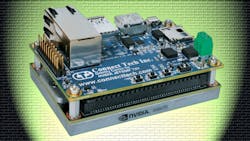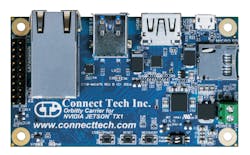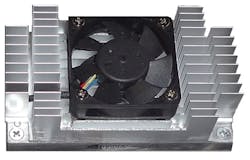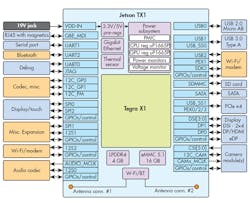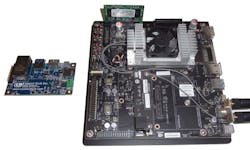I found NVidia’s Jetson TX1 module to be a great mobile and embedded platform for handling video, as well as for machine learning applications. The module is built around a chip that includes four ARM Cortex-A57 cores in addition to a 256-core Maxwell architecture GPU that delivers up to 1 TFLOPS of performance.
The development kit for the Jetson TX1 exposes all the interfaces provided by the module, and even has space for a video camera. The large board is not designed for deployment, especially when a developer is working to keep the package closer to the size of the module.
This is where’s ConnectTech’s Orbitty (Fig. 1) comes in. It is the same form factor (50 mm by 87 mm) as the Jetson TX1 module (Fig. 2). The Orbitty provides connections for gigabit Ethernet, USB 3.0, USB 2.0 OTG, HDMI, two 3.3V UARTs, I2C, and four GPIOs. It also has a microSD socket. It is designed to operate in temperatures from −40° C to +85° C. The power voltage is between 9 VDC and 14 VDC.
The Orbitty provides access to most of the interfaces available on the Jetson TX1 (Fig. 3). The Jetson TX1 has built-in Wi-Fi and Bluetooth support with a pair of antennas that connect directly to the module. This means an Orbitty system can support a wireless connection.
Mating the Jetson TX1 to the Orbitty is a trivial exercise. It was just a matter of adding power and connections to the outside world. The module has its own flash and RAM memory, so it was just a matter of starting up the Orbitty system with it connected to an HDMI display and USB keyboard and mouse. I also had a pair of wireless PCB antennas that worked nicely to provide wireless support. Of course, running it headless and wireless was the goal so it could be used with the iRobot Create 2. The combination takes a bit more power than using a Raspberry Pi or Arduino, but the Jetson TX1 is capable of crunching video input.
The difference in size between the development board and the Orbitty is significant (Fig. 4). The development board was never designed for deployment, but the Orbitty is. There will still be instances where a custom board may be appropriate, such as one that might have a one or more cameras built in, but this platform should be applicable to a wide range of applications.
Just in case the Orbitty is not what you need, there are alternatives. ConnectTech has a number of other boards and systems that support the NVidia Jetson TX1. These include the Astro Carrier and Elroy Carrier. The Elroy has a pair of compact Mini-PCIe expansion sockets. The Rosie is a small form factor case that has the connections mounted on the cover. The connections have IP68-rated Ingress protection.
About the Author
William Wong Blog
Senior Content Director
Bill's latest articles are listed on this author page, William G. Wong.
Bill Wong covers Digital, Embedded, Systems and Software topics at Electronic Design. He writes a number of columns, including Lab Bench and alt.embedded, plus Bill's Workbench hands-on column. Bill is a Georgia Tech alumni with a B.S in Electrical Engineering and a master's degree in computer science for Rutgers, The State University of New Jersey.
He has written a dozen books and was the first Director of PC Labs at PC Magazine. He has worked in the computer and publication industry for almost 40 years and has been with Electronic Design since 2000. He helps run the Mercer Science and Engineering Fair in Mercer County, NJ.
- Check out more articles by Bill Wong on Electronic Design
- Bill Wong on Facebook
- @AltEmbedded on Twitter
